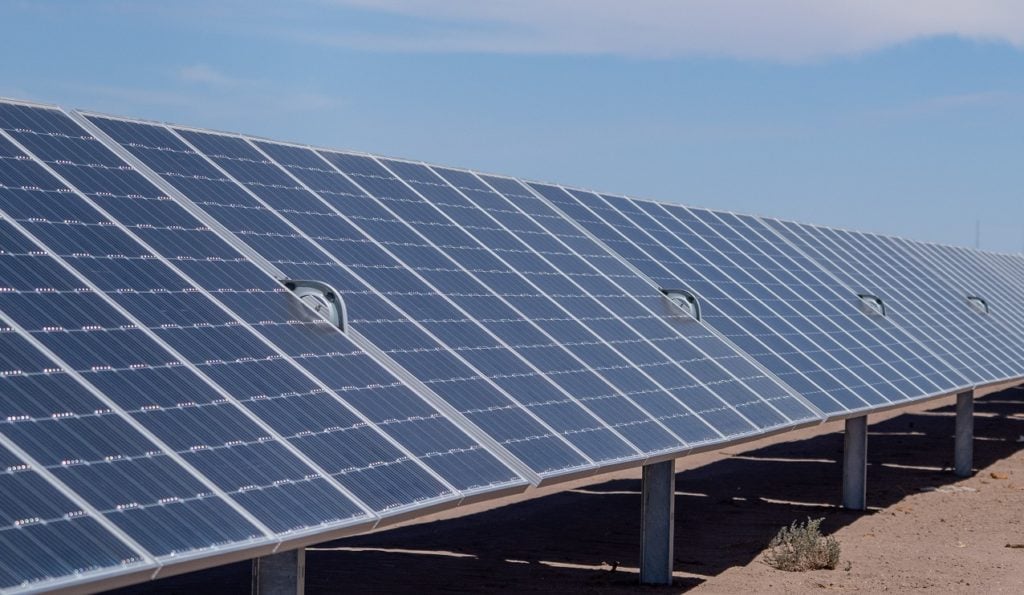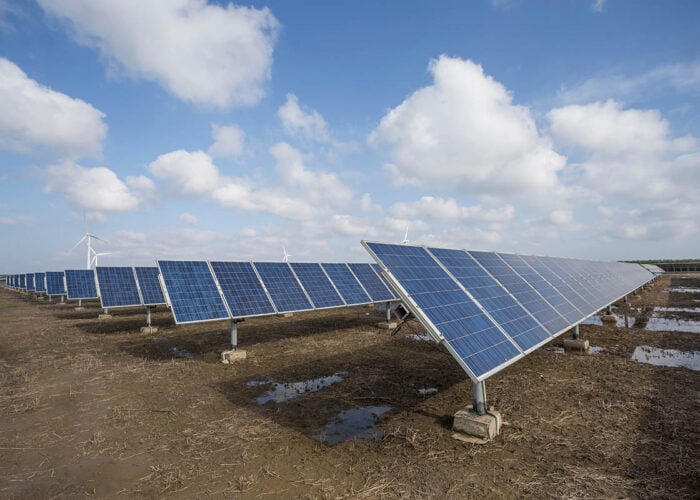
Chile has long been one of the highest-potential countries for solar development, considering its high levels of solar irradiance. Last year, Darío Morales, director of studies at Asociación Chilena de Energía Renovables y Almacenamiento, Chile’s renewables and storage trade association, told PV Tech Premium that a solar plant installed in the north of Chile would produce “30-35%” more energy than the same project built in the south of Spain, with climatic conditions providing an all but ideal environment for solar power generation.
The Chilean solar sector has been buoyed by recent government support for new small-scale projects through the Pequeños Medios de Generación Distribuido (PMGD) programme, an initiative that sees projects with a capacity of up to 9MW granted automatic grid access with no curtailment, and transmission toll reductions.
Unlock unlimited access for 12 whole months of distinctive global analysis
Photovoltaics International is now included.
- Regular insight and analysis of the industry’s biggest developments
- In-depth interviews with the industry’s leading figures
- Unlimited digital access to the PV Tech Power journal catalogue
- Unlimited digital access to the Photovoltaics International journal catalogue
- Access to more than 1,000 technical papers
- Discounts on Solar Media’s portfolio of events, in-person and virtual
The PMGD programme has sought to encourage new small-scale development, with power generation located in the regions where energy is consumed, and has helped drive a steady increase in solar capacity additions in Chile in recent years. In July 2021, Chile had installed a cumulative capacity of 3.7GW, and this had almost doubled to 7.3GW by July 2023.
The next step for the Chilean solar sector, therefore, will be finding a way to encourage large-scale capacity additions. This will require considerable investment – with the International Energy Agency reporting that Latin America and the Caribbean, as a whole, will need to invest US$150 billion into its renewable energy sectors by 2030 – and a number of companies are starting to commit some of this funding.
In October this year, international renewable energy provider Sonnedix acquired a 416MW portfolio from Enel and Arcadia Generación Solar for over half a billion dollars, a considerable investment in the Chilean solar sector. Yet these projects are already in commercial operation, representing a movement of existing resources rather than the construction of new projects, and could prove to be something of a springboard for Sonnedix’s long-term plans in the Chilean market.
A range of acquisitions
“Chile is a key market for Sonnedix,” Daniel Garrido, Sonnedix’s head of growth Americas and Chile general manager, told PV Tech Premium. “The acquisition of Arcadia Generación was an opportunity to rapidly grow our operational footprint and complemented our existing portfolio. In fact it is our largest ever acquisition of operating assets – across our entire global portfolio – to date.”
Garrido noted that the deal has increased Sonnedix’s operating capacity in Chile to over 1GW, and the acquisition of operating projects, rather than those at an earlier stage of development, has yielded immediate returns for the company. He went on to explain that the company has no “one size fits all” approach to expanding its Chilean portfolio, instead eager to invest in whatever projects have the potential for long-term growth, and this approach has yielded immediate returns in a jurisdiction where there is considerable solar growth.
Indeed, in the last six months alone, Opdenergy and Enel Green Power have made progress on power purchase agreements and new construction initiatives in Chile, as interest grows in the country’s renewables sector.
“The operating environment in Chile is favourable in that the regulatory framework and culture are both business-friendly and highly supportive of enabling the energy transition,” explained Garrido, pointing to a range of factors that has encouraged Sonnedix’s investment in Chile.
“With the acquisition of the Arcadia portfolio, we have established Sonnedix as a key player are working hard to convert a pipeline of approximately 1.5GW of wind, solar and storage projects to provide even more clean, reliable, and affordable energy to Chilean homes.”
However, this rapid expansion of renewable projects in particular has raised questions for the Chilean energy grid, and the capability of grid infrastructure to meet the demands of a rapidly-shifting energy mix. Chile currently experiences more than 2,000 zero-price hours each year – when more energy is produced than is required to meet the country’s energy demand – which has put a limit on the effectiveness of new power generation facilities, particular in the growing renewable sector.
Storage and grid reliability
The need for Chile to rapidly alter its grid infrastructure is particularly relevant considering the government’s plans to shut down its coal plants by 2040. Research published in July this year by Wärtsilä noted that, in order for Chile to meet its energy needs without coal, it will have to install 21.8GW of solar capacity by 2040, alongside 3.3GW of energy storage, with both integral to the future of the Chilean energy mix.
However, a number of battery developers have become more active in the Chilean sector, with 12 projects with a combined capacity of 1.3GW scheduled to come online this year. In total, 85 projects are under development in Chile, with a combined capacity of 6.4GW, and while not all of this capacity will be brought online in the short-term, the rapid growth in the sector is encouraging; for instance, earlier this year, AES Anders commissioned a 180MW solar-plus-storage project in the country.
“Storage, in particular, can provide flexibility to the grid which is critical to both reliability and resilience as more and more power is derived from renewable sources,” said Garrido. “Sonnedix has experience in operating battery energy storage systems (BESS) and this is an area where we are actively assessing opportunities currently.”
While Sonnedix has worked in the storage sector, much of this has been alongside wind power, rather than in solar. Last month, the company submitted environmental impact assessments for a 92MW wind-plus-storage project, the Carica Wind Park, with a total investment of US$290 million, a move that reaffirms the company’s commitment to investments in the Chilean power grid over involvement in a particular form of renewable energy generation.
“We support the reinforcing of the transmission system as the right thing to do to remove any market disruption, and are keen to work with stakeholders to install storage systems at scale and ensure the grid is prepared and stable so that Chile can achieve its targets,” added Garrido.
A hybrid portfolio
This approach, of investing in a range of technologies, all with the aim of reinforcing and reshaping Chile’s energy grid, is emblematic of what Garrido called Sonnedix’s commitment to building a “hybridised portfolio” in the country.
“Since 2015, we’ve been rapidly growing our presence and diversifying our portfolio in the country to leverage the significant scale and potential it offers,” explained Garrido.
“We’ve already begun our hybridisation journey in Chile with the acquisition of Arco Energy in October 2022, adding wind assets to our solar portfolio,” added Garrido. “This diversification is important as a hybrid portfolio enables us to better match customer needs and to navigate today’s energy challenges, addressing affordability, reliability, security [and] flexibility of power.”
The Arco Energy deal brought 290MW of new renewable power capacity into Sonnedix’s portfolio which, when considered alongside its other activities in Chile, demonstrates this breadth of projects. Its acquisition of Arco Energy is an example of purchasing an independent power producer in its entirety, while its purchase of the portfolio from Arcadia Generación Solar and Enel is an acquisition of a component within a larger corporate structure.
Alongside these acquisitions, greenfield developments such as the Carica wind-plus-storage farm demonstrate the range of activities the company is completing in Chile, and reflects a breadth of operations appropriate for a country that is trying to rapidly alter its energy mix.
In 2021, fossil fuels produced 45.7TWh of electricity, with coal accounting for 25.7TWh; the government aims to reduce the contribution of coal to zero within 20 years. While this raises questions as to how best to implement this transition – questions that are also to be answered by Sonnedix, which is trying to manage a number of decarbonisation initiatives simultaneously – the ambition of these proposals is admirable.
“This is a cornerstone of Sonnedix’s strategy to reach a growing end customer base and support companies in decarbonising high carbon industries via corporate offtake agreements for secure and clean energy,” concluded Garrido. “We’re excited about the significant momentum we are building in Chile, and look forward to continuing to play a key role in the country’s energy transition.”







